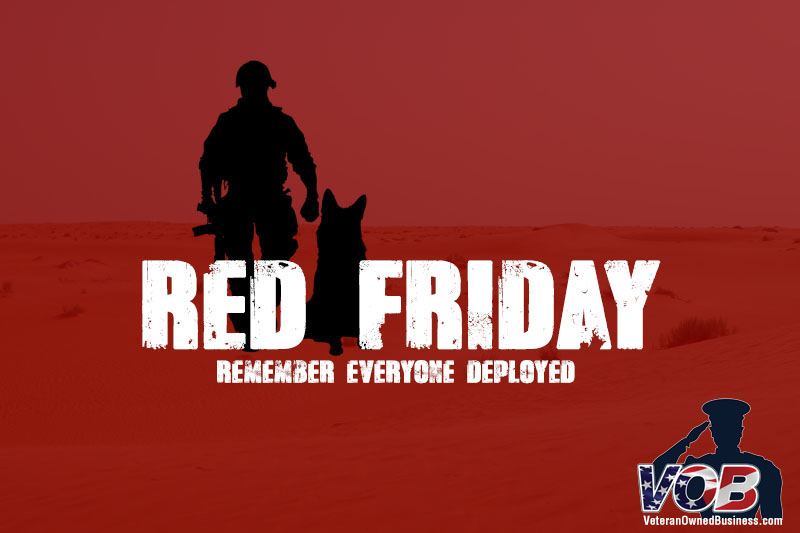Sign up for your free VOB listing!
Add your VOB/SDVOSB!
Veteran Business Owners: join Nearly 40,000 other businesses proudly owned by veterans, active duty, reservists, service disabled veterans and military spouses! Get your company's FREE profile and be seen by millions of fellow veterans, government agencies, prime/sub contractors, corporate purchasing departments and every day consumers strongly support businesses owned by those who proudly served/serve our great nation! It's FREE!

Already a member? login here
Have a question?
(877) VOB-List
VOB on Facebook
SDVOSB/VOSB Contracting Resources
The Veteran Owned Business Project
- Veteran Owned Business Project's Mission
- Get your company's free profile and listing in the Veteran Owned Business Directory
- List of Veteran Owned Businesses By Industry
- List of Veteran Owned Businesses By State
- Search Veteran Owned Businesses and SDVOSBs/DVBEs by NAICS Codes
- Military Veteran Owned Franchises
- Nonprofit Organization Members
- Who’s Who of VOB Users and Supporters
Military and Veterans Discounts, Freebies and Special Offers
VOB Syndication
Subscribe to our Newsletter
More
Recent Posts
 Ongoing (Year-Round) Military Appreciation Discounts (many for veterans too)
Ongoing (Year-Round) Military Appreciation Discounts (many for veterans too) Statement of Work: Amarillo VA Health Care System Advertising Services
Statement of Work: Amarillo VA Health Care System Advertising Services GRANITE CONSTRUCTION COMPANY is Seeking DBE Qualified Sub-Contractors: Ackerman Creek Bridge Replacement for Mendocino Department of Transportation
GRANITE CONSTRUCTION COMPANY is Seeking DBE Qualified Sub-Contractors: Ackerman Creek Bridge Replacement for Mendocino Department of Transportation USDA Announces Up to $12 Million in Grant Funding Available to Promote U.S. Agricultural Products and Address Food Insecurity in Underserved Communities
USDA Announces Up to $12 Million in Grant Funding Available to Promote U.S. Agricultural Products and Address Food Insecurity in Underserved Communities Invitation to Bid City of Ukiah Great Redwood Trail Phase 4 – Granite Construction Company Seeking Qualified Subcontractors (DBE/DVBE/SBE/WBE/MBE)
Invitation to Bid City of Ukiah Great Redwood Trail Phase 4 – Granite Construction Company Seeking Qualified Subcontractors (DBE/DVBE/SBE/WBE/MBE)
Archives
Events Calendar
Calendar of Events
M Mon
T Tue
W Wed
T Thu
F Fri
S Sat
S Sun
5 events,
FREE Security Guard Training Bundle for US Veterans
FREE Security Guard Training Bundle for US Veterans
Get ready for the ultimate FREE Security Guard Training Bundle exclusively for US Veterans, starting on January 11, 2024 at 1:00 PM! About this event CAS American Veterans Foundation will be sponsoring FREE Security...
Active Retired Vets Learn to utilize your skill set in the civilian world
Learn to transition and utilize our service-connected talents into a recession proof business. (THIS IS NOT A NETWORKING EVENT)
April Fool’s Day
April Fool's Day Click here to see a full list of military holidays, birthdays, anniversaries and observances! (adsbygoogle = window.adsbygoogle || []).push({});
Month of the Military Child
April is the Month of the Military Child April is "Month of the Military Child" (Military Child Appreciation Month). This month (and every month) we celebrate and support military children and recognize the sacrifices...
CEO Roundtable April
CEO Roundtable April
The CEO Round Table provides professional development for veteran and military spouse small business owners. About this event The CEO Round Table is a high-level gathering that offers a unique opportunity to engage with...
14 events,
Soldiers Return: Coming Home from Vietnam
Soldiers Return: Coming Home from Vietnam
Exhibit at the Watkins About this event Over three million Americans served in the Vietnam War; they returned home to a fractured nation. Lacking support systems and an understanding community, Vietnam veterans created organizations...
MVPN: Military Cultural Competency Training
MVPN: Military Cultural Competency Training
Military Cultural Competency Training About this event Training is offered both in-person and virtual. It is our purpose and passion to find volunteers interested in helping service members, Veterans, and their family members; to...
Hampton Roads Military Community Employer Connect (Southside)
Hampton Roads Military Community Employer Connect (Southside)
Come and expand your professional network each week with our Virginia Values Veterans (V3) certified companies. About this event Welcome to the Hampton Roads Military Community Employer Connect! This event is a fantastic opportunity for...
MACRA – Baton Rouge Monthly Meeting
MACRA – Baton Rouge Monthly Meeting
This event is a networking event for all veteran related organizations to collaborate! About this event Your organization is invited to participate in a network of community resources group that will provide resources for...
MACRA – Baton Rouge Monthly Meeting
MACRA – Baton Rouge Monthly Meeting
This event is a networking event for all veteran related organizations to collaborate! About this event Your organization is invited to participate in a network of community resources group that will provide resources for...
7 events,
Active Retired Vets Learn to utilize your skill set in the civilian world
Learn to transition and utilize our service-connected talents into a recession proof business. (THIS IS NOT A NETWORKING EVENT)
Soldiers Return: Coming Home from Vietnam
Soldiers Return: Coming Home from Vietnam
Exhibit at the Watkins About this event Over three million Americans served in the Vietnam War; they returned home to a fractured nation. Lacking support systems and an understanding community, Vietnam veterans created organizations...
Wednesday, April 3 Expanding Our Understanding of Military Sexual Trauma
Wednesday, April 3 Expanding Our Understanding of Military Sexual Trauma
Equipping clinicians with the knowledge, skills, and sensitivity needed to provide effective care for individuals who have experienced MST. Date and time Wednesday, April 3 · 12:30 - 5:30pm CDT Location The...
Intrepid After Hours: Apollo: When We Went to the Moon
Intrepid After Hours: Apollo: When We Went to the Moon
Military veterans and service members can experience the Intrepid Museum after hours with a behind-the-scenes tour and catered dinner. About this event Intrepid After Hours: Apollo: When We Went to the Moon Join fellow...
Women Veteran Meetup
Women Veteran Meetup
Women veterans of all era's please join us for an evening of camaraderie and conversation at The Steven A. Cohen military Family Clinic. About this event Women Veteran Meetup Join us for the Women...
10 events,
Soldiers Return: Coming Home from Vietnam
Soldiers Return: Coming Home from Vietnam
Exhibit at the Watkins About this event Over three million Americans served in the Vietnam War; they returned home to a fractured nation. Lacking support systems and an understanding community, Vietnam veterans created organizations...
Veteran’s Coffee Social
Veteran’s Coffee Social
Are you a veteran? Join our veteran's community for a once-a-month coffee social. Coffee and pastries are provided. Select date and time Tuesday, November 21 · 9 - 10am CST Location Cleveland...
MVPN: Military Cultural Competency Training
MVPN: Military Cultural Competency Training
Military Cultural Competency Training About this event Training is offered both in-person and virtual. It is our purpose and passion to find volunteers interested in helping service members, Veterans, and their family members; to...
MVPN: Military Cultural Competency Training
MVPN: Military Cultural Competency Training
Military Cultural Competency Training About this event Training is offered both in-person and virtual. It is our purpose and passion to find volunteers interested in helping service members, Veterans, and their family members; to...
Grey Team’s 3rd Annual – They Are Not Bulletproof Gala
Grey Team’s 3rd Annual – They Are Not Bulletproof Gala
Immerse yourself in an evening of unparalleled patriotism and respect as we celebrate the remarkable bravery of our nation’s military heroes. About this event BOCA RATON'S MOST ANTICIPATED EVENT IS BACK. Grey Team’s "They...
20 events,
RED Friday – Remember Everyone Deployed
RED Friday (Remember Everyone Deployed) Every Friday is #REDFriday - a day where military supporters wear red to remember all of our brave men and women who are deployed away from home and are...
Gold Star Wives Day
Gold Star Wives Day Click here to see a full list of military holidays, birthdays, anniversaries and observances!
Gold Star Spouses Day
Gold Star Spouses Day (in the past known as Gold Star Wives Day) About Gold Star Spouses Day. Thousands of widows are honored every year during Gold Star Spouses Day, April 5, to remember...
Soldiers Return: Coming Home from Vietnam
Soldiers Return: Coming Home from Vietnam
Exhibit at the Watkins About this event Over three million Americans served in the Vietnam War; they returned home to a fractured nation. Lacking support systems and an understanding community, Vietnam veterans created organizations...
VCV’s 3rd Annual Military Sexual Trauma Conference
VCV’s 3rd Annual Military Sexual Trauma Conference
Get ready for VCV's 3rd Annual Military Sexual Trauma Conference, a powerful gathering to address and tackle the important issue of sexual t VCV's 3rd Annual Military Sexual Trauma Conference Join us for VCV's...
Veterans Luncheon
Veterans Luncheon
Calling All Veterans! About this event Calling All Veterans! Please join us on the First Friday of each Month from 10:30am – 1pm. For our Monthly Veterans Luncheon at the West Dallas Multipurpose Center...
#VeteranWorks Virtual Job Fair / Career Expo #Veterans Event #San Francisco
#VeteranWorks Virtual Job Fair / Career Expo #Veterans Event #San Francisco
Attend World's Largest Virtual Job Expo / Career Fair #Veterans #Hiring Drive #San Francisco at https://jobfair.tao.ai/pod/veteranworks About this event 🎖️ Veterans, are you ready to take the next step in your professional journey? The...
#VeteranWorks Virtual Job Fair / Career Expo #Veterans Event #Orlando
#VeteranWorks Virtual Job Fair / Career Expo #Veterans Event #Orlando
Attend World's Largest Virtual Job Expo / Career Fair #Veterans #Hiring Drive #Orlando at https://jobfair.tao.ai/pod/veteranworks About this event 🎖️ Veterans, are you ready to take the next step in your professional journey? The "VeteransWorks.org...
16 events,
Active Retired Vets Learn to utilize your skill set in the civilian world
Learn to transition and utilize our service-connected talents into a recession proof business. (THIS IS NOT A NETWORKING EVENT)
Clemson University Mile of Honor- 2024
Clemson University Mile of Honor- 2024
The Mile Of Honor remembers those Clemson Alumni who made the ultimate sacrifice in service to our country. About this event We will meet at the President's Rotunda, in President's Park. The formal program...
Veteran Social Club Warrior Hikes: Gold Strike Hot Springs
Veteran Social Club Warrior Hikes: Gold Strike Hot Springs
Hike with Veteran Social Club to Gold Strike Hot Springs April 6th, at the Lake Mead National Recreation Area! About this event Warrior Hikes: Gold Strike Hot Springs, Lake Meade National Recreation Area These monthly...
American Legion Department of Minnesota Shooting Competition
American Legion Department of Minnesota Shooting Competition
This event is a shooting competition and fundraiser for The American Legion's Minnesota Veterans Assistance Fund. All are welcome. About this event This shooting competition is for veterans and non-veterans alike. Proceeds benefit the...
How to Start and Manage Your Own Business: 4/6/2024
How to Start and Manage Your Own Business: 4/6/2024
LIVE EVENT (ONLINE) About the event Do you have what it takes to start and run a successful business? If so, what are the first steps you should take? This workshop will help you...
Starting Your New Business
Starting Your New Business
LIVE EVENT (ONLINE) About the event This workshop is designed to guide you through the steps necessary for starting a business. It covers the different legal business entities, licenses needed, taxes and insurance. We...
7 events,
National Beer Day
April 7th is National Beer Day! IF (ok who are we kidding)... WHEN you go out to enjoy a few beers today, why not check out these breweries, bars and other drinking establishments that...
Winter Warrior
Winter Warrior
Get ready for the biggest event in AZ where people come together to bring awareness to Veteran and 1st Responder suicide. Winter Warrior - In Person Event Winter Warrior The primary objective is to bring...
Island Quarter Auction at Veterans Memorial Center – Sykes Creek Parkway
Island Quarter Auction at Veterans Memorial Center – Sykes Creek Parkway
The American Legion Auxiliary Unit 344 along with the American Legion Post 344 and VFW 12167 are working together to hold a monthly quarter auction (1st Sunday of the month) at the beautiful Veterans...
Hoops for Heroes in Honor of Joe Perry Jr
Hoops for Heroes in Honor of Joe Perry Jr
Four Legged Angels - Save a dog to Save a life About this event Hoops for Heroes in Honor of Joe Perry Jr Come join us for a thrilling basketball event at Tiverton High School!...
4 events,
FREE Security Guard Training Bundle for US Veterans
EXECUTIVE MILITARY TRANSITION SEMINAR (PENINSULA)
EXECUTIVE MILITARY TRANSITION SEMINAR (PENINSULA)
Senior Level Military Professionals need more than just basic transition courses. They need real-world HR & talent acquisition expertise. Conquer Your Toughest Deployment Yet: The Military-to-Civilian Transition The transition to the civilian job market...
10 events,
National Former POW Recognition Day
April 9th is designated by Congress as the Presidentially proclaimed observance of National Former POW Recognition Day. On this day we honor the American servicemen and women who experienced unimaginable trials and profound cruelty...
Hampton Roads Military Community Employer Connect (Southside)
Hampton Roads Military Community Employer Connect (Southside)
Come and expand your professional network each week with our Virginia Values Veterans (V3) certified companies. About this event Welcome to the Hampton Roads Military Community Employer Connect! This event is a fantastic opportunity for...
Fund Your Business with Sponsors, Even if You’re Just Starting Out
Fund Your Business with Sponsors, Even if You’re Just Starting Out
LIVE EVENT (ONLINE) About the event Would you like to do what you love and have someone else foot the bill? Have you ever thought about corporate sponsors for your business, show, book, charity, speaking...
Pelvic Power Hour: Living with Endometriosis, A Journey from Pain to Power
Pelvic Power Hour: Living with Endometriosis, A Journey from Pain to Power
Join us for a virtual Pelvic Power Hour, released on demand on 4/9, to learn about living with endometriosis and reclaiming your power! About this event Endometriosis, affecting 1 in 10 women globally, shares...
Navigating Minority & Woman-Owned Business Certification (Apr)
Navigating Minority & Woman-Owned Business Certification (Apr)
LIVE EVENT (ONLINE) About the event Ever thought of applying for government or corporate contracts? Will certifications give you access to more opportunities? And if so, what certifications should you have? It’s...
How to Become WBE Certified – 04/09/2024
How to Become WBE Certified – 04/09/2024
LIVE EVENT (ONLINE) About the event Becoming certified as a Women's Business Enterprise (WBE) provides access to supplier diversity and procurement executives at hundreds of major U.S. corporations and federal, state and local government...
11 events,
Active Retired Vets Learn to utilize your skill set in the civilian world
Learn to transition and utilize our service-connected talents into a recession proof business. (THIS IS NOT A NETWORKING EVENT)
NYPD MILITARY SEMINAR
NYPD MILITARY SEMINAR
Join us for the NYPD Military Seminar, where you'll gain valuable insights and learn essential skills from experienced military resources. About this event NYPD MILITARY SEMINAR Join us for an exciting and informative event...
Accredited Certificate in Beauty Nutrition | 1-Day Training (8CE/CPD elig.)
Accredited Certificate in Beauty Nutrition | 1-Day Training (8CE/CPD elig.)
Skin is not a stomach! Learn to help your clients feed their skin from within with a holistic nutrition approach. About this event LIVE CLASS ON APRIL 10, 2024 via ZOOM Skin is literally...
Life Sciences & Healthcare Job Fair For Veterans JOB SEEKER REGISTRATION
Life Sciences & Healthcare Job Fair For Veterans JOB SEEKER REGISTRATION
Free Event for those transitioning to Civilian Life or with Civilian Experience. Open to Vets, National Guard, Military Spouses & Families. Date and time Wednesday, April 10 · 10am - 2pm EDT Location...
2024 Star Veterans Senior Expo & Health Fair- Theme: Fun Fiesta
2024 Star Veterans Senior Expo & Health Fair- Theme: Fun Fiesta
Join us for a fiesta-themed expo with lots of resources for senior citizens, veterans, their families & caregivers. We want to empower you! About this event Join us for a fun fiesta themed expo...
Veteran’s Involved Parkinson’s
Veteran’s Involved Parkinson’s
Join us for "Veteran's Involved Parkinson's" where veterans unite against Parkinson's disease, happening on Every 2nd Wednesday of Month. Select date and time! Wednesday, March 13 · 12 - 1pm PDT Location...
10 events,
Women’s Business Conference – The Climb 2024
Women’s Business Conference – The Climb 2024
LIVE EVENT (IN PERSON) About the event The CLIMB 2024 - Orlando's premier event for Women Entrepreneurs. A full day of engaging speakers, luncheon, networking and more! REGISTER NOW
04-11-24 Sales vs Marketing
04-11-24 Sales vs Marketing
LIVE EVENT (ONLINE) About the event What’s the Difference between Sales and Marketing? And Why Does it Matter?! Growing a small business is not for the faint of heart. You know you are capable...
RED, White, and Blue Hiring Event Military Excellence Growth Association
RED, White, and Blue Hiring Event Military Excellence Growth Association
Join us at the military veteran career fair to meet companies ready to hire you. Open to the public! Explore new opportunities! About this event This is a great opportunity for transitioning military personnel,...
Bellevue Career Fair – Bellevue Job Fair
Bellevue Career Fair – Bellevue Job Fair
Meet, sit down and interview with Nationally Known employers at The Seattle Career Fair - Sale & Professional Job Fair. About this event Seattle Bellevue Job Fair and Career Fair - Sales & Professional...
Seattle Career Fair – Seattle Job Fair
Seattle Career Fair – Seattle Job Fair
Meet, sit down and interview with Nationally Known employers at The Seattle Career Fair - Sales & Professional Job Fair. About this event Seattle Bellevue Job and Career Fair - Professional Diversity Hiring Event...
9 events,
RED Friday – Remember Everyone Deployed
RED Friday (Remember Everyone Deployed) Every Friday is #REDFriday - a day where military supporters wear red to remember all of our brave men and women who are deployed away from home and are...
Dr. Joe Dispenza Change Your Mind Create New Results
Dr. Joe Dispenza Change Your Mind Create New Results
An Advanced Training Program Designed By Dr Joe Dispenza Hosted By Anastasia About this event The program, called “Change Your Mind, Create New Results” (CYM CNR) program is based on 30 years of the neuroscience of...
Whole Vet & NC State Military Career Transition Day
Whole Vet & NC State Military Career Transition Day
Network with business leaders and representatives from major corporations, educational institutions, and Veteran services organizations. About this event Whole Vet & NC State Military Career Transition Day Join us for the Whole Vet &...
Indoor Cornhole Tournament – Veteran Charity Fundraiser
Indoor Cornhole Tournament – Veteran Charity Fundraiser
Join us for a thrilling indoor cornhole tournament, where we'll have a blast while raising funds for new tools sets for Veterans in Industry About this event Join us for an exciting Indoor Cornhole...
TLE Doylestown’s LUXE Bag Bingo for Make-A-Wish & Healthlink Dental Clinic
TLE Doylestown’s LUXE Bag Bingo for Make-A-Wish & Healthlink Dental Clinic
Please join us for LUXE Bag Bingo to benefit The Make-A-Wish Foundation! About this event TLE Doylestown has two missions this year: Make a Wish and Healthlink Dental Clinic! Each non-profit will split all the proceeds...
Third Annual Regrow Monroe Fundraiser to benefit Monroe Street Cemetery
Third Annual Regrow Monroe Fundraiser to benefit Monroe Street Cemetery
Join us for our third annual fundraiser to help restore and preserve Ohio City's largest greenspace, the historic Monroe Street Cemetery. About this event Celebrate Spring with drinks, food, music and raffle prizes! Your...
15 events,
Active Retired Vets Learn to utilize your skill set in the civilian world
Learn to transition and utilize our service-connected talents into a recession proof business. (THIS IS NOT A NETWORKING EVENT)
TYLER VETERANS’ ENTREPRENEURSHIP BOOT CAMP – MANAGEMENT, MONEY & MARKETING
TYLER VETERANS’ ENTREPRENEURSHIP BOOT CAMP – MANAGEMENT, MONEY & MARKETING
Date and time. Saturday, April 13 · 8am - 4pm CDT Location TC Energy Building/TJC West REGISTER NOW
Combat Veterans Motorcycle Association 27-11 Poker Run
Combat Veterans Motorcycle Association 27-11 Poker Run
3rd Annual Combat Vets 27-11 Ridge Riders Poker Run About this event This is a Rain or Shine event! Registration 9-11am Last bike out at 11am Last bike in at 1:30pm Cash Prizes for...
Recover Restore Renew
Recover Restore Renew
Come join us at Recover Restore Renew for a day of rejuvenation, where we'll help you recharge, heal, and find new energy. About this event Recover Restore Renew Come join us for an amazing...
Women Veteran Art Workshop Series
Women Veteran Art Workshop Series
Calling all Women Veterans! Join us for an empowering in-person art workshop series starting on Saturday Feb 10, 2024 at 10 am! About this event Join us for a fun and creative art workshop...
Veteran’s Support Group
Veteran’s Support Group
RHI is here to serve as an additional support for our Veterans. About this event This Veteran’s Support Group is design to offer a safe space to discuss military experiences that you may have...
4 events,
Air Force Reserve Birthday
Air Force Reserve Birthday Click here to see a full list of military holidays, birthdays, anniversaries and observances! (adsbygoogle = window.adsbygoogle || []).push({});
5 events,
FREE Security Guard Training Bundle for US Veterans
Online Workshop: Facebook Marketing
Online Workshop: Facebook Marketing
LIVE EVENT (ONLINE) About the event Are you looking to expand your business and make it more competitive? With Facebook marketing, you can get the edge over your competition. In this free workshop, you...
Are YOU SBA Ready?
Are YOU SBA Ready?
LIVE EVENT (ONLINE) About the event If you need funding for your business and can't get on Shark Tank, register for this webinar! You'll learn what steps are required to get approved for and...
7 events,
Hampton Roads Military Community Employer Connect (Southside)
Hampton Roads Military Community Employer Connect (Southside)
Come and expand your professional network each week with our Virginia Values Veterans (V3) certified companies. About this event Welcome to the Hampton Roads Military Community Employer Connect! This event is a fantastic opportunity for...
How to start selling in Amazon’s Store
How to start selling in Amazon’s Store
LIVE EVENT (ONLINE) About the event In this session, discover if you’re ready to sell in Amazon’s store and how to get started. Learn the fundamentals of selling with Amazon including what to...
Amazon Listing Accelerator: Strategies for Sales Growth
Amazon Listing Accelerator: Strategies for Sales Growth
LIVE EVENT (ONLINE) About the event Are you eager to elevate your product presence and sales on Amazon? In this session, we'll dive into the critical aspects of crafting compelling product listings. From...
Resources and Refreshments
Resources and Refreshments
Every third Tuesday learn about resources available in the community for veterans and individuals transitioning out of service. About this event Resources and Refreshments Military connected and free to attend! Join us on the...
9 events,
Active Retired Vets Learn to utilize your skill set in the civilian world
Learn to transition and utilize our service-connected talents into a recession proof business. (THIS IS NOT A NETWORKING EVENT)
2024 Symposium in Support of Service Members, Veterans & Their Families
2024 Symposium in Support of Service Members, Veterans & Their Families
The Arizona Coalition for Military Families and our public & private planning partners invite you to attend the 2024 Statewide Symposium. About this event The Arizona Coalition for Military Families and our public &...
Camp Plymouth Military Vehicle Show & Swap Meet
Camp Plymouth Military Vehicle Show & Swap Meet
The largest annual show for ex-military vehicles (MVs) west of the Mississippi, since the late 1970s! Military parts, collectibles sales. Date and time April 17 · 8am - April 20 · 9pm PDT...
Using AI to Increase your Marketing Productivity
Using AI to Increase your Marketing Productivity
LIVE EVENT (ONLINE) About the event Are you curious about artificial intelligence (AI) content generation and how it works? Do you want to learn how AI can save you time and make your marketing...
Veteran Coffee on the Farm
Veteran Coffee on the Farm
Coffee & conversation with fellow veterans in a relaxed atmosphere Select date and time. Wednesday, April 17 · 10 - 11:30am EDT Location Equine Assisted Development 3224 32nd Street Southeast Grand Rapids, MI 49512...
Veteran Coffee on the Farm
Veteran Coffee on the Farm
Coffee & conversation with fellow veterans in a relaxed atmosphere About this event Wednesday, February 21 · 10:00 AM Location Equine Assisted Development 3224 32nd Street Southeast Grand Rapids, MI 49512 REGISTER NOW ...
8 events,
Military Heroes Car Show- 2nd Annual
Military Heroes Car Show- 2nd Annual
Join us at the Military Heroes Car Show for a day of honoring our servicemen and women with classic and custom vehicles. About this event Our mission at the Military Heroes Car Show is...
TRAINING-ReBOOT: Substance Use Disorder Recovery Level 2: Apr 11, 18, 25
TRAINING-ReBOOT: Substance Use Disorder Recovery Level 2: Apr 11, 18, 25
ReBOOT Substance Use Disorder Recovery Level 2 Training 3 days from 9:00 a.m. - 4:30 p.m. About this event Virginia Department of Veterans Service (DVS)Grant Funded ‘FREE’ Career Training for Service Members, Veterans, and...
2024 HIRE VETS NOW – Fort Gregg-Adams Registration
2024 HIRE VETS NOW – Fort Gregg-Adams Registration
HIRE VETS NOW is dedicated to connecting those who serve and their families to career and SkillBridge opportunities in Virginia. EVENT DAT ES: April 18 September 19 TIME: 11am - 1pm (complimentary lunch provided) LOCATION: Army...
2024 HIRE VETS NOW – Joint Base Myer-Henderson Hall Registration
2024 HIRE VETS NOW – Joint Base Myer-Henderson Hall Registration
HIRE VETS NOW is dedicated to connecting those who serve and their families to career and SkillBridge opportunities in Virginia. EVENT DATES: April 18 November 7 TIME: 11:00am - 1:00pm (complimentary lunch provided) LOCATION: Spates Community...
2024 Symposium in Support of Service Members, Veterans & Their Families
2024 Symposium in Support of Service Members, Veterans & Their Families
The Arizona Coalition for Military Families and our public & private planning partners invite you to attend the 2024 Statewide Symposium. About this event The Arizona Coalition for Military Families and our public &...
7 events,
RED Friday – Remember Everyone Deployed
RED Friday (Remember Everyone Deployed) Every Friday is #REDFriday - a day where military supporters wear red to remember all of our brave men and women who are deployed away from home and are...
Clean Comedy Series w Nick Harvey & Jenn Weeks, Hosted by Mike Freed
Clean Comedy Series w Nick Harvey & Jenn Weeks, Hosted by Mike Freed
Laugh your socks off at Murray Hill Theatre. GA tix are $20 Preshow and $25 at the Door. Limited Premium seats $25 . About this event Nick Harvey is one of the funniest up and...
DoD Skillbridge EXPO (Peninsula)- JOINT BASE EUSTIS
DoD Skillbridge EXPO (Peninsula)- JOINT BASE EUSTIS
Would you like to grow your Professional network with some of America’s vetted DoD Skillbridge Programs? Here is your chance! About this event At our Centers, one of the most common questions we receive...
Steven A. Cohen Clinic at Valley Cities Annual Banquet Fundraiser
Steven A. Cohen Clinic at Valley Cities Annual Banquet Fundraiser
Celebrating 5 years. The Cohen Clinic 5th Anniversary Fundraiser helps post 9/11 veterans and military families get the care they need. About this event Please join us on Friday, April 19 at 5:45 p.m....
11 events,
Active Retired Vets Learn to utilize your skill set in the civilian world
Learn to transition and utilize our service-connected talents into a recession proof business. (THIS IS NOT A NETWORKING EVENT)
Church & Christian School Safety Training – Level 1
Church & Christian School Safety Training – Level 1
Biblically based and ministry focused training. We give practical tips, tools, and techniques to keep people safe from all threats. About this event Church & Christian School Safety Training - Level 1 Lynnfield, MA...
Veteran Ride for Wellness
Veteran Ride for Wellness
Come out and enjoy the day with us while supporting a great cause. About this event Come join us at Rally Point Harley-Davidson for a fun day while supporting a good cause. We’re going...
RESCHEDULED for 2024 – iCruise4Her! Honoring our US Military Family
RESCHEDULED for 2024 – iCruise4Her! Honoring our US Military Family
Polish that chrome! Shine those Wheels! REV-Up that Engine! Showcase your ride or SIGNUP to take home an award in your CLASS! About this event FUN FAMILY DAY! Show off your ride and take...
VA Loan Crash Course
VA Loan Crash Course
Unlock your homebuying potential with your VA Loan! The essential guide to getting started in homeownership with your VA Loan. Join us! About this event Attention, Military Veterans (that includes you Active Duty)! Are...
VAREP 8th Annual Poker Run
VAREP 8th Annual Poker Run
Join us for the 8th Annual VAREP Poker Run on April 20th - let's ride, play poker, and have a blast together! About this event We are the USA Homeownership Foundation DBA Veterans Association...
5 events,
Operation ReCon – Wehr Nature Center Hike
Operation ReCon – Wehr Nature Center Hike
An afternoon hike with veterans, exploring the healing experience of nature. About this event We would love to have you join us for this afternoon exploration of the Wehr Nature Center. Last year the...
American Bombshells
American Bombshells
ALL AGES A modern-day twist on the Andrews Sisters, traveling the globe with an All-American show that dazzles in three-part harmony! About this event American Patriotic Services., is a 501(c)(3) organization with a mission,"To...
5 events,
FREE Security Guard Training Bundle for US Veterans
Military Monday: Art & Canvas Painting
Military Monday: Art & Canvas Painting
Peaceful, relaxing, fun canvas painting sessions for Veterans and Active Military at Joyful Studio on every Fourth Monday! About this event Attention Veterans & Active Military! Relax your mind with art & canvas painting....
Inclusive Dance and Movement for Veterans – April 2024
Inclusive Dance and Movement for Veterans – April 2024
Get moving and connect with other veterans from the Durham VA! About this event Military veterans and their families are invited to participate in a FREE workshop that combines fitness, martial arts, dance, and...
11 events,
Army Reserve Birthday
Army Reserve Birthday On 23 April 1908 Congress created the Medical Reserve Corps, the official predecessor of the Army Reserve. After World War I, under the National Defense Act of 1920, Congress reorganized the...
EMPOWERING Veterans To Invest In Real Estate
EMPOWERING Veterans To Invest In Real Estate
Empowering Veterans to Invest in Real Estate About this event 🏠 Unlock Your Next Mission: From Military Service to Real Estate Success! 🇺🇸 Attention Veterans! Ready to embark on your financial journey after serving...
EXECUTIVE MILITARY TRANSITION SEMINAR (SOUTHSIDE)
EXECUTIVE MILITARY TRANSITION SEMINAR (SOUTHSIDE)
Senior Level Military Professionals need more than just basic transition courses. They need real-world HR & talent acquisition expertise. About this event Conquer Your Toughest Deployment Yet: The Military-to-Civilian Transition The transition to the...
Hampton Roads Military Community Employer Connect (Southside)
Hampton Roads Military Community Employer Connect (Southside)
Come and expand your professional network each week with our Virginia Values Veterans (V3) certified companies. About this event Welcome to the Hampton Roads Military Community Employer Connect! This event is a fantastic opportunity for...
MAC Military History Club
MAC Military History Club
Speaker shares their impression of important military history events. Date and time Tuesday, April 23 · 11:30am - 1pm CDT Location Missouri Athletic Club 405 Washington Ave St Louis, MO 63102 GET...
When Banks Say No
When Banks Say No
LIVE EVENT (ONLINE) About the event It’s tough for small businesses to get funding. In fact, 80-85% of small business loan requests are denied by banks. So, what’s a small business owner to do...
6 events,
National Lingerie Day
Today (April 24) is #NationalLingerieDay. While we know it's another on a list of frivolous "events"... we figured it's a good time to plug the handful of Veteran Owned Lingerie business members! Click here...
Active Retired Vets Learn to utilize your skill set in the civilian world
Learn to transition and utilize our service-connected talents into a recession proof business. (THIS IS NOT A NETWORKING EVENT)
Veteran Talent Academy: “Basic Training”
Veteran Talent Academy: “Basic Training”
Veteran Talent Academy's HYBRID "Basic Training" provides Veteran-hiring fundamentals to help you jump-start your hiring initiative. About this event Do you know how to find Veteran talent? Understand military culture? Use Veteran-hiring best practices?...
24 Texas Veterans Land Board
24 Texas Veterans Land Board
This educational session provides insights into the VLB's various services. About this event The Texas Land Board, also known as the Veterans Land Board (VLB), offers valuable resources and programs for realtors working with...
7 events,
April 25, 2024 8th Annual Jesse Ramirez Memorial Golf Classic
April 25, 2024 8th Annual Jesse Ramirez Memorial Golf Classic
Swing into Action! 8th Annual Golf Tournament: End Homelessness for Veterans at VHA1.org. Register Now & Help Sponsor a Veteran! About this event CLICK HERE TO REGISTER: vha1.org Seize the Opportunity to Make a...
Oakland County Veterans Resource Fair
Oakland County Veterans Resource Fair
Available for all veterans, active duty, guard and reserves, and their families. Giveaways include food boxes and community resources. REGISTER NOW resentatives will be onsite to serve all veterans, active duty, guard and reserves,...
TRAINING-ReBOOT: Substance Use Disorder Recovery Level 2: Apr 11, 18, 25
TRAINING-ReBOOT: Substance Use Disorder Recovery Level 2: Apr 11, 18, 25
ReBOOT Substance Use Disorder Recovery Level 2 Training 3 days from 9:00 a.m. - 4:30 p.m. About this event Virginia Department of Veterans Service (DVS)Grant Funded ‘FREE’ Career Training for Service Members, Veterans, and...
Vino Simpatico Wine Tasting on April 25th 2024
Vino Simpatico Wine Tasting on April 25th 2024
Join us at Vino Simpatico for a wine tasting benefiting Dive Care. About this event hours Divecare is hosting a wine tasting and we’d love to have you join us! Your $30 donation provides...
8 events,
RED Friday – Remember Everyone Deployed
RED Friday (Remember Everyone Deployed) Every Friday is #REDFriday - a day where military supporters wear red to remember all of our brave men and women who are deployed away from home and are...
Tax Essentials for New and Existing Business Owners | 4/26/2024
Tax Essentials for New and Existing Business Owners | 4/26/2024
LIVE EVENT (ONLINE) About the event Paying taxes is inevitable. But reporting and paying the right amount of taxes timely is the goal you want to achieve to give you peace of mind and allow...
Best Ways to Grow Your Business on a Budget
Best Ways to Grow Your Business on a Budget
LIVE EVENT (ONLINE) About the event With so many marketing options available for small businesses, where should you allocate your budget and resources in order to maximize results? You’re not alone if you feel...
Naval Base San Diego Hiring Event
Naval Base San Diego Hiring Event
Naval Base San Diego Career Fair About this event FREE ADMISSION: Open to ALL branches of service active duty, reservists, veterans, family members and DoD employees. Title Sponsor: Boeing Click the green register button...
Access to Business Capital
Access to Business Capital
About the event ACCESS TO BUSINESS CAPITAL 4/26/2024 NOON EDT FREE ON ZOOM In this workshop you will gain insights into options available to get funding for starting a small business and growing a...
13 events,
Famous Veterans Born April 27th: Jack Klugman
Wishing Jack Klugman a happy angel birthday today! Jack Klugman stared on several hit TV shows including: Quincy M.E. and, of course, as Oscar Madison on The Odd Couple. But did you know that...
Active Retired Vets Learn to utilize your skill set in the civilian world
Learn to transition and utilize our service-connected talents into a recession proof business. (THIS IS NOT A NETWORKING EVENT)
Operation Thank A Vet 8th Annual Golf Tournament: Journey Back to the 1920s
Operation Thank A Vet 8th Annual Golf Tournament: Journey Back to the 1920s
Come join us for the Thank A Vet 8th Annual Golf Tournament, where we'll be swinging our clubs in style with a 1920s theme. About this event Thank A Vet 8th Annual Golf Tournament...
Daisy Walk Murrieta- Mental Wellness Meet-Up
Daisy Walk Murrieta- Mental Wellness Meet-Up
Share your art, services, and/or products that promote mental and emotional wellness to thousands; as a sponsor and/or vendor! FREE WINGMAN's LUNCH COMBO TO THE FIRST 100 WALKERS (a valid veteran or military service-connected...
CGTLEA NY 7th Annual DC3 Nate Bruckenthal “Bruck” Workout
CGTLEA NY 7th Annual DC3 Nate Bruckenthal “Bruck” Workout
The 7th Annual DC3 Nate Bruckenthal "Bruck" Workout will benefit the Coast Guard Tactical Law Enforcement New York Chapter. About this event The 7th Annual DC3 Nate Bruckenthal "Bruck" Workout will be held at...
Women Veteran Art Workshop Series
Women Veteran Art Workshop Series
Calling all Women Veterans! Join us for an empowering in-person art workshop series starting on Saturday Feb 10, 2024 at 10 am! About this event Join us for a fun and creative art workshop...
Veteran’s Journey Resource Fair
Veteran’s Journey Resource Fair
Veterans, this one’s for you! Meet local organizations that provide free resources for veterans and their families! About this event Date and time. Saturday, April 27 · 11am - 4pm EDT Location Al-Marah...
4 events,
Badger’s Veteran Food Crawl & Missions at Yellow Green Farmers Market
Badger’s Veteran Food Crawl & Missions at Yellow Green Farmers Market
Explore Florida's largest farmers market by completing missions with Badger, an app that turned the market into an open world game! About this event Badger's monthly Veteran Food Crawl & Gamified Missions at Yellow...
4 events,
FREE Security Guard Training Bundle for US Veterans
Military Cultural Training
Military Cultural Training
Join us for a presentation on the uniqueness of military culture and to help better serve our veterans and military members. About this event This 1-hour presentation is designed to help civilian members understand...
7 events,
National Bugs Bunny Day
National Bugs Bunny Day Today, April 30th, is #NationalBugsBunnyDay! We know you are probably asking, "why is a site about military veterans and the military community posting information about National Bugs Bunny Day?"... here's...
National Military Brats Day
National Military Brats Day Today, April 30th, is #NationalMilitaryBratDay! Today we pay tribute to the often overlooked sacrifices of the children of active duty military personnel. Imagine never having a home for more than...
Hampton Roads Military Community Employer Connect (Southside)
Hampton Roads Military Community Employer Connect (Southside)
Come and expand your professional network each week with our Virginia Values Veterans (V3) certified companies. About this event Welcome to the Hampton Roads Military Community Employer Connect! This event is a fantastic opportunity for...
THE VETERANS MUSEUM AT PATRIOT PARK HOSTS A FUNDRAISER FOR HOMELESS VETS
THE VETERANS MUSEUM AT PATRIOT PARK HOSTS A FUNDRAISER FOR HOMELESS VETS
THE VETERANS MUSEUM AT PATRIOT PARK AND DR. KARLA M. KORNEGAY, MBA CONTINUE TO RAISE MONEY FOR DISADVANTAGED AND HOMELESS VETERANS About this event Being homeless, or being at risk of homelessness, is one...
8 events,
Loyalty Day
Loyalty Day (recognizing the American spirit of loyalty) Click here to see a full list of military holidays, birthdays, anniversaries and observances! Loyalty Day is observed on May 1 in the United States. It...
Silver Star Service Banner Day
Silver Star Service Banner Day Click here to see a full list of military holidays, birthdays, anniversaries and observances! Silver Star Service Banner Day was created by The Silver Star Families of America (SSFOA);...
National Military Appreciation Month
National Military Appreciation Month (NMAM), as designated by Congress, provides a period encompassing both the history and recognition of our armed services with an in-depth look at the diversity of its individuals and achievements....
Month of the Military Caregiver
Month of the Military Caregiver The month of May is #MonthoftheMilitaryCaregiver. It's a time to honor the millions of caregivers in the United States who care for veterans and their families. Click here to...
Active Retired Vets Learn to utilize your skill set in the civilian world
Learn to transition and utilize our service-connected talents into a recession proof business. (THIS IS NOT A NETWORKING EVENT)
Building and Expanding your Business AND Protecting your Business
Building and Expanding your Business AND Protecting your Business
LIVE EVENT (ONLINE) About the event During this workshop we talk about business credit, why it is important to create business credit and how it can help with planning and expansion of a business....
Free Course: Spiritual Leadership: YOU ARE THE SOURCE OF YOUR DESTINY
Free Course: Spiritual Leadership: YOU ARE THE SOURCE OF YOUR DESTINY
Free Course: Spiritual Leadership: YOU ARE THE SOURCE OF YOUR DESTINY dance.Get ready to dive into the world of spiritual leadership with our free ongoing online sessions. About this event Free ongoing Spiritual Leadership...
12 events,
THE VETERAN’S MUSEUM AT PATRIOT PARK HOSTS A FUNDRAISER FOR HOMELESS VETS
THE VETERAN’S MUSEUM AT PATRIOT PARK HOSTS A FUNDRAISER FOR HOMELESS VETS
THE VETERAN'S MUSEUM AT PATRIOT PARK AND DR. KARLA M. KORNEGAY, MBA CONTINUE TO RAISE MONEY FOR DISADVANTAGED AND HOMELESS VETERANS About this event Being homeless, or being at risk of homelessness, is one...
Veteran’s Coffee Social
Veteran’s Coffee Social
Are you a veteran? Join our veteran's community for a once-a-month coffee social. Coffee and pastries are provided. Select date and time Tuesday, November 21 · 9 - 10am CST Location Cleveland...
MVPN: Military Cultural Competency Training
MVPN: Military Cultural Competency Training
Military Cultural Competency Training About this event Training is offered both in-person and virtual. It is our purpose and passion to find volunteers interested in helping service members, Veterans, and their family members; to...
MVPN: Military Cultural Competency Training
MVPN: Military Cultural Competency Training
Military Cultural Competency Training About this event Training is offered both in-person and virtual. It is our purpose and passion to find volunteers interested in helping service members, Veterans, and their family members; to...
THE VETERANS MUSEUM AT PATRIOT PARK HOSTS A FUNDRAISER FOR HOMELESS VETS
THE VETERANS MUSEUM AT PATRIOT PARK HOSTS A FUNDRAISER FOR HOMELESS VETS
THE VETERAN'S MUSEUM AT PATRIOT PARK AND DR. KARLA M. KORNEGAY, MBA CONTINUE TO RAISE MONEY FOR DISADVANTAGED AND HOMELESS VETERANS About this event Being homeless, or being at risk of homelessness, is one...
18 events,
RED Friday – Remember Everyone Deployed
RED Friday (Remember Everyone Deployed) Every Friday is #REDFriday - a day where military supporters wear red to remember all of our brave men and women who are deployed away from home and are...
Uniquely You: Strategies To Enhance Your Personal Brand
Uniquely You: Strategies To Enhance Your Personal Brand
Get ready to boost your personal brand with practical strategies and unleash your uniqueness in our online event "Uniquely You" starting on About this event Uniquely You: Strategies To Enhance Your Personal Brand Join...
#VeteranWorks Virtual Job Fair / Career Expo #Veterans Event #Seattle
#VeteranWorks Virtual Job Fair / Career Expo #Veterans Event #Seattle
Attend World's Largest Virtual Job Expo / Career Fair #Veterans #Hiring Drive #Seattle at https://jobfair.tao.ai/pod/veteranworks About this event 🎖️ Veterans, are you ready to take the next step in your professional journey? The "VeteransWorks.org...
#VeteranWorks Virtual Job Fair / Career Expo #Veterans Event #Orlando
#VeteranWorks Virtual Job Fair / Career Expo #Veterans Event #Orlando
Attend World's Largest Virtual Job Expo / Career Fair #Veterans #Hiring Drive #Raleigh at https://jobfair.tao.ai/pod/veteranworks About this event 🎖️ Veterans, are you ready to take the next step in your professional journey? The "VeteransWorks.org...
#VeteranWorks Virtual Job Fair / Career Expo #Veterans Event #Orlando
#VeteranWorks Virtual Job Fair / Career Expo #Veterans Event #Orlando
Attend World's Largest Virtual Job Expo / Career Fair #Veterans #Hiring Drive #Orlando at https://jobfair.tao.ai/pod/veteranworks About this event 🎖️ Veterans, are you ready to take the next step in your professional journey? The "VeteransWorks.org...
#VeteranWorks Virtual Job Fair / Career Expo #Veterans Event #Sacramento
#VeteranWorks Virtual Job Fair / Career Expo #Veterans Event #Sacramento
Attend World's Largest Virtual Job Expo / Career Fair #Veterans #Hiring Drive #Sacramento at https://jobfair.tao.ai/pod/veteranworks About this event 🎖️ Veterans, are you ready to take the next step in your professional journey? The "VeteransWorks.org...
6 events,
Active Retired Vets Learn to utilize your skill set in the civilian world
Learn to transition and utilize our service-connected talents into a recession proof business. (THIS IS NOT A NETWORKING EVENT)
An Uplifting Affair – the Uplift Internationale 2024 Gala
An Uplifting Affair – the Uplift Internationale 2024 Gala
Join us for An Uplifting Affair, a night of celebration and inspiration, where we'll come together to raise funds for Operation Taghoy 2025 About this event A glamorous night awaits you at the Uplift Internationale Gala....
2024 Medal of Honor Dinner
2024 Medal of Honor Dinner
Please Join us for the Friends of the Medal of Honor Grove Dinner to support this living memorial dedicated to preserving the legacy of the over 3500 recipients. The Grove is open to the...
5 events,
Women Veterans Informational Tea
Women Veterans Informational Tea
Join our 2nd Annual Informational Tea where women veterans come together to sip, share experiences, and explore self-care. About this event The Village of Park Forest Veterans’ Commission invites you to a delightful and relaxing afternoon...
Island Quarter Auction at Veterans Memorial Center – Sykes Creek Parkway
Island Quarter Auction at Veterans Memorial Center – Sykes Creek Parkway
The American Legion Auxiliary Unit 344 along with the American Legion Post 344 and VFW 12167 are working together to hold a monthly quarter auction (1st Sunday of the month) at the beautiful Veterans...
















